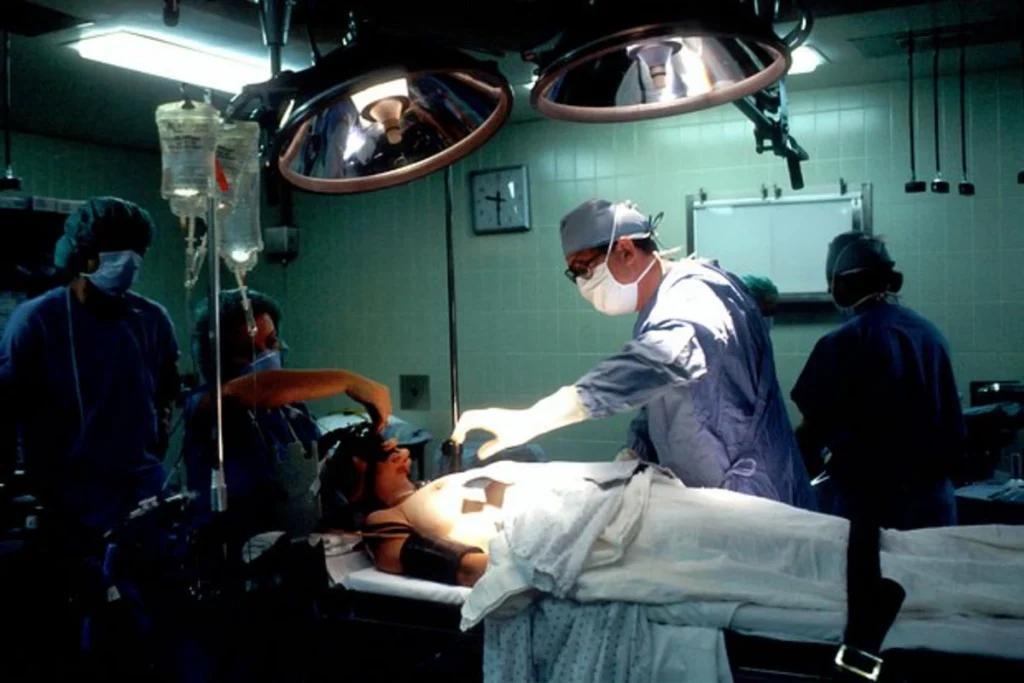Last Updated on November 25, 2025 by
After a man has his prostate removed, the main aim is to stop cancer. But, there are often side effects that affect how he functions. Knowing what might happen is key, as this big surgery can be scary.

A radical prostatectomy takes out the whole prostate gland and some nearby tissue. It’s a good way to fight prostate cancer. Even though it works well, patients might face different side effects. It’s important to know what these could be to better understand and deal with them.
Understanding prostatectomy is key when facing prostate cancer or issues. This surgery removes the prostate gland and some tissues. It aims to remove cancer or disease, improving life quality and survival chances.

There are different prostate removal surgeries. Open prostatectomy uses one big incision. Laparoscopic prostatectomy uses small incisions and a camera. Robotic-assisted prostatectomy is a laparoscopic surgery with a robotic system for better precision.
Each surgery has its own benefits and risks. Robotic surgery is precise and may have shorter recovery times. But, it’s not available everywhere. The right surgery depends on health, cancer stage, and surgeon’s skill.
Prostate removal is mainly for prostate cancer. It’s also for severe BPH that doesn’t respond to other treatments. The decision is made after a thorough evaluation and discussion with the healthcare provider.
Studies show prostatectomy can be effective but has side effects. 5“30% may face urinary incontinence, and 30“70% may have erectile dysfunction. Knowing these risks helps manage expectations.
Preparation for prostate surgery includes several steps. Patients stop certain medications and undergo health tests. These tests assess their health and prostate condition.
Patients also get advice on recovery preparation. This includes post-surgery care at home and lifestyle changes. Our healthcare team ensures patients are ready for surgery and recovery.
Prostate removal surgery starts a recovery journey with several important parts. These include the hospital stay, managing pain, and using a catheter. Knowing about these can help patients get ready for their recovery.
How long you stay in the hospital after surgery can vary. Usually, it’s a few days. Medical staff watch over you, manage pain, and look for any complications. Being in the hospital is key for quick care if needed.
Managing pain well is very important during recovery. Doctors use different methods to reduce pain, like medicine and other treatments. We work with patients to find the best pain plan for them, so they can feel comfortable while recovering.
A urinary catheter is put in during surgery and stays for about a week. It helps the urethra heal without strain. Patients learn how to take care of it at home until a healthcare provider removes it.

Recent studies show that new surgical methods, like robotic-assisted procedures, can improve outcomes. These advancements are making prostate removal surgery better, leading to quicker and smoother recoveries for patients.
After a prostatectomy, men often face changes in how they use the bathroom. This can really affect their daily life. Incontinence, or the loss of bladder control, is a common issue. It happens to between 5% and 30% of patients. Knowing about incontinence rates and treatments is key to dealing with this side effect.
Studies show that many men deal with incontinence after prostate surgery. The rate can be as high as 30%. But, most men get better over time.
Recent studies have shown that incontinence rates go down as time passes. For example, one study found the rate drops to about 5% two years after surgery. This shows the importance of patience and proper care after surgery.
The outlook for long-term bladder control is good. Studies say up to 89.8% of men stay continent 15 years after surgery. This means incontinence is often a short-term issue, but most men regain control later on.
Factors influencing long-term continence include the surgery method, age at surgery, and overall health. We’ll look into these factors to give a full picture of what to expect.
There are many ways to manage incontinence after prostate surgery. Pelvic floor exercises, or Kegel exercises, are very effective. They help strengthen the muscles that control urination. Most patients find these exercises helpful.
Other treatments like behavioral therapy and medication might also be suggested. For severe cases, surgery could be an option. We’ll dive into these choices to help patients understand their options.
It’s important for patients to talk to their doctor about their situation. This way, they can find the best treatment. By knowing their options and staying positive, men can manage urinary changes after prostate surgery and improve their life quality.
Men who have had prostate removal surgery need to know how it affects their sex life. This surgery can change a man’s sexual health and how he connects with his partner.
Erectile dysfunction (ED) is a common issue after prostate removal surgery. Research shows that 30% to 70% of men face ED after the surgery, even with nerve-sparing methods. This wide range depends on the man’s age, health, and the surgery type.
For more info on dealing with erectile dysfunction, check out Cancer Research UK. They offer detailed advice and support.
The time it takes for sexual function to recover varies. Some men regain erectile function in a few months, while others may take up to two years or more. The recovery depends on the nerve damage during surgery and post-operative care.
Nerve-sparing techniques used during prostatectomy can greatly help. These methods aim to keep the nerves around the prostate intact, which are key to erectile function.
There are several ways to manage erectile dysfunction after prostate removal. These include:
Men should talk to their healthcare provider about these options. This helps find the best treatment plan for their situation.
Advanced surgical techniques have changed prostate surgery for the better. They offer hope to patients needing prostate removal. These new methods have greatly improved cancer control and recovery.
Robotic-assisted prostatectomy is a top choice for surgery. It’s better than old-school open surgery. This method uses a robot to help the surgeon be more precise and reduce blood loss.
The good things about robotic-assisted prostatectomy are:
Research shows it helps control cancer better and improves erections. Patients see big improvements in their ability to have erections.
NeuroSAFE surgery is another big deal in prostate surgery. It checks nerves during surgery to keep erections working. This lets doctors make changes on the spot to help with erections.
The good things about NeuroSAFE surgery are:
Choosing the right surgery depends on many things. Like your health, cancer stage, and the surgeon’s skill. It’s key to talk to your doctor to find the best surgery for you.
When looking at new surgery options, remember:
After a prostatectomy, patients often wonder about their long-term health and survival prospects. Understanding the long-term implications of this surgery is key to making informed health decisions.
Studies show that long-term survival rates after prostate removal are excellent. A significant percentage of men survive beyond ten years after surgery. In fact, 91% of men are alive ten years after prostatectomy, showing the treatment’s effectiveness for prostate cancer.
Life expectancy after prostate removal is a big concern for patients. The good news is that, for many men, prostatectomy is a highly effective treatment. It significantly improves long-term survival. According to recent studies, the life expectancy after prostate removal is generally favorable. Many men live for decades after surgery without recurrence.
It’s important to remember that individual outcomes can vary. This depends on factors like the cancer’s stage at diagnosis, overall health, and any other medical conditions.
Ongoing monitoring is a key part of post-prostatectomy care. Regular check-ups and tests help catch any recurrence or complications early. This monitoring includes PSA (Prostate-Specific Antigen) tests, imaging studies, and clinical evaluations.
By staying vigilant and following the recommended follow-up schedule, patients can improve their long-term health outcomes. They can also enjoy a high quality of life after prostate removal surgery.
Understanding and managing changes and side effects is key after prostate surgery. We’ve looked at the surgery and its long-term effects.
Men can do well with the right support and guidance. Knowing about side effects and treatments helps a lot. It’s important for a smooth recovery and adjusting to life after surgery.
Most men can adapt with the right care and support. Life after surgery might need some changes. But with the right attitude and resources, men can live active and happy lives.
Prostate removal, or radical prostatectomy, is a surgery for prostate cancer. It removes the prostate gland and some surrounding tissues. It’s needed when cancer is only in the prostate.
There are several types, like open, laparoscopic, and robotic-assisted prostatectomy. Each has its own benefits and drawbacks. The choice depends on your situation and the surgeon’s skill.
Hospital stays vary, but most are a few days. It depends on your health and the surgery’s complexity.
We use medicines and techniques to reduce pain. This helps you recover smoothly.
A urinary catheter helps the bladder heal. It’s removed a few weeks after surgery. Proper care is key to avoiding problems.
Some incontinence is common, but it varies. Most men regain control with time and treatments.
Recovery time for sexual function varies. It depends on the surgery and your health. Treatments can help restore function.
Robotic-assisted surgery offers better precision and less blood loss. It leads to quicker recovery and fewer side effects.
NeuroSAFE surgery aims to protect nerves for erectile function. This can improve sexual function after surgery.
Life expectancy after surgery depends on cancer stage and health. Successful treatment and monitoring are key for a good prognosis.
Most men have good cancer control long-term. Regular monitoring is important for the best outcome.
Yes, living without a prostate is possible. Some adjustments may be needed, but many men adapt well and enjoy life.
Some side effects, like incontinence or erectile dysfunction, may be permanent. But treatments can help manage these issues.
Managing incontinence involves exercises, lifestyle changes, and treatments. We guide you on the best ways to regain control.
Subscribe to our e-newsletter to stay informed about the latest innovations in the world of health and exclusive offers!